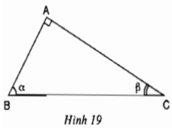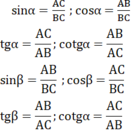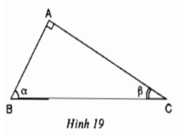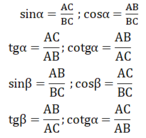Hãy nhập câu hỏi của bạn vào đây, nếu là tài khoản VIP, bạn sẽ được ưu tiên trả lời.

\(cot\alpha=\dfrac{40}{9}\Rightarrow tan\alpha=\dfrac{1}{cot\alpha}=\dfrac{1}{\dfrac{40}{9}}=\dfrac{9}{40}\)
+) \(\dfrac{1}{cos^2\alpha}=1+tan^2\alpha\)
\(\Leftrightarrow\dfrac{1}{cos^2\alpha}=1+\left(\dfrac{9}{40}\right)^2\\ \Rightarrow cos\alpha=\sqrt{1:\left(1+\left(\dfrac{9}{40}\right)^2\right)}=\dfrac{40}{41}\)
+) \(sin^2\alpha=1-cos^2\alpha\)
\(\Leftrightarrow sin\alpha=\sqrt{1-cos^2\alpha}=\sqrt{1-\left(\dfrac{40}{41}\right)^2}=\dfrac{9}{41}\)

Ta có sin α = 3 5 suy ra sin 2 α = 9 25 , mà sin 2 α + cos 2 α = 1 , do đó:
cos 2 α = 1 - sin 2 α = 1 - 9 25 = 16 25 suy ra cos α = 4 5
Do đó:
tan α = sin α cos α = 3 5 : 4 5 = 3 5 . 5 4 = 3 4
c o t α = cos α sin α = 4 5 : 3 5 = 4 5 . 5 3 = 4 3
Vậy cos α = 4 5 ; tan α = 3 4 ; c o t α = 4 3
Đáp án cần chọn là: B


ta co \(sin^2a+cos^2a=1\Rightarrow cosa=0.36\)
\(\frac{sina}{cosa}=tana\Rightarrow tana=\frac{20}{9}\)
\(tana\cdot cotga=1\Rightarrow cotga=\frac{9}{20}\)
câu b tương tự nha cau c \(\frac{sina+cosa}{sina-cosa}=\) bn

Ta có \(x^2+y^2=1\Leftrightarrow\left(x+y\right)^2=2xy+1\)
Từ đó \(P=\dfrac{\left(x+y\right)^2}{x+y+1}\). Đặt \(x+y=t\left(t\ge0\right)\). Vì \(x+y\le\sqrt{2\left(x^2+y^2\right)}=2\) nên \(t\le\sqrt{2}\). ĐTXR \(\Leftrightarrow x=y=\dfrac{1}{\sqrt{2}}\). Ta cần tìm GTLN của \(P\left(t\right)=\dfrac{t^2}{t+1}\) với \(0\le t\le\sqrt{2}\).
Giả sử có \(0\le t_1\le t_2\le\sqrt{2}\). Ta có BDT luôn đúng \(\left(t_2-t_1\right)\left(t_2+t_1+t_2t_1\right)\ge0\) \(\Leftrightarrow t_2^2-t_1^2+t_2^2t_1-t_2t_1^2\ge0\) \(\Leftrightarrow t_1^2\left(t_2+1\right)\le t_2^2\left(t_1+1\right)\) \(\Leftrightarrow\dfrac{t_1^2}{t_1+1}\le\dfrac{t_2^2}{t_2+1}\) \(\Leftrightarrow P\left(t_1\right)\le P\left(t_2\right)\). Như vậy với \(0\le t_1\le t_2\le\sqrt{2}\) thì \(P\left(t_1\right)\le P\left(t_2\right)\). Do đó P là hàm đồng biến. Vậy GTLN của P đạt được khi \(t=\sqrt{2}\) hay \(x=y=\dfrac{1}{\sqrt{2}}\), khi đó \(P=2\sqrt{2}-2\)
Lời giải:
$P=\frac{2xy+1}{x+y+1}=\frac{2xy+x^2+y^2}{x+y+1}=\frac{(x+y)^2}{x+y+1}$
$=\frac{a^2}{a+1}$ với $x+y=a$
Áp dụng BĐT AM-GM:
$1=x^2+y^2\geq \frac{(x+y)^2}{2}=\frac{a^2}{2}$
$\Rightarrow a^2\leq 2\Rightarrow a\leq \sqrt{2}$
$P=\frac{a^2}{a+1}=\frac{a}{1+\frac{1}{a}}$
Vì $a\leq \sqrt{2}\Rightarrow 1+\frac{1}{a}\geq 1+\frac{1}{\sqrt{2}}=\frac{2+\sqrt{2}}{2}$
$\Rightarrow P\leq \frac{\sqrt{2}}{\frac{2+\sqrt{2}}{2}}=-2+2\sqrt{2}$
Vậy $P_{\max}=-2+2\sqrt{2}$ khi $x=y=\frac{1}{\sqrt{2}}$



